Affiliate disclosure: This post may contain affiliate links. Please see our Privacy Policy.
Canning plums is a simple way to preserve plums for year-round use. Plums can be preserved as halves or wholes (with pits or without), and canned in your choice of water, juice, or syrup.
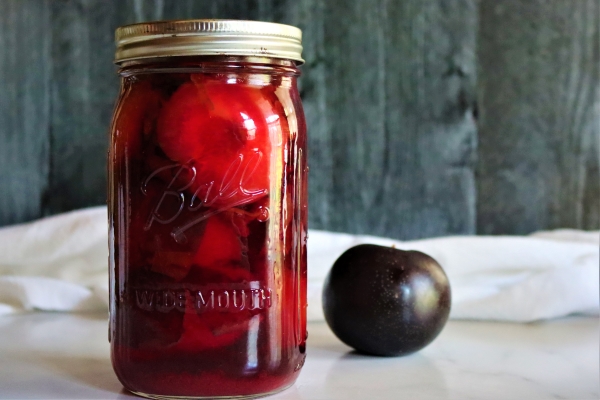
Plums are one of our best crops, and dependably produce buckets of fruit every year. We make plum jam, plum butter, and even plum wine from our homegrown plums (and from thickets of wild plums at the edge of the woods).
Their season is short, but I still find time to bake up a plum torte or two in the busy harvest season. They’re spectacular, and I’ve been looking for a way to preserve plums that’d allow me to make them during the winter too.
This past year, I came across a few cans of Oregon Canned Whole Plums at the store, and realized that canning plums may be the solution to enjoying my favorite plum recipes year-round!
Choosing & Preparing Plums for Canning
Believe it or not, plums actually hold up remarkably well during canning. I found that they had a firmer texture than my home-canned peaches, and they maintained their shape whether canned as whole or halves.
Plums can actually be canned whole, with the pit intact, if you choose. That’s a good option for clingstone fruit that just won’t pit cleanly. Keep in mind though, if you don’t pit the plums before canning, you’re just packing away a chore for later.
For small clingstone fruit, like wild plums and damsons, I use a cherry pitter and it’s incredibly effective.

When canning whole plums, prick the outsides of the fruit skin with a toothpick, fork, or knife to prevent the skin from popping. A little space for expansion means they’ll hold their shape better in the jar.
For freestone plums, you can simply cut the fruit in half and remove the pit before canning.
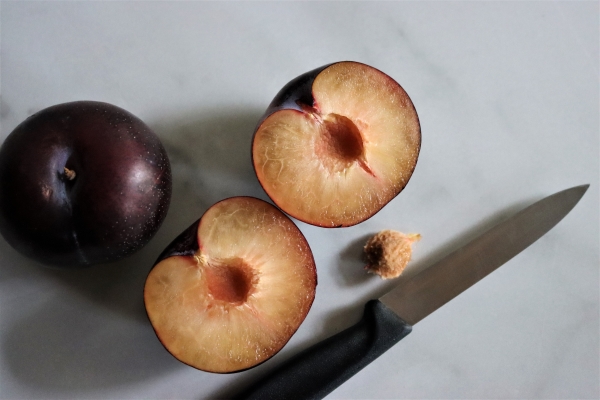
Whether canning whole plums or plum halves, be sure to choose fully ripe fruit at the peak of freshness. They should be in prime condition for fresh eating, sweet and a bit soft. Not so soft, however, that they just completely fall apart in your hand as you bite them. (ie. Perfectly ripe, but not overripe.)
Hot Pack or Raw Pack Methods
Plums are approved for canning as either a hot pack fruit, or a raw pack fruit. Generally speaking, hot pack fruit has a better quality than raw pack fruit, but it’s a bit more work.
Hot Pack ~ This involves blanching, or partially cooking the plums before packing them into the jars. They’ll lose some air from their tissues, which will help prevent floating in the jars and allow them to pack tighter. The downside is that you’ll be loading the fruit while it’s hot, which is a bit messier than just loading raw fruit.
To hot pack plums, bring the canning liquid (syrup, water or juice) to a boil. Add plums, return to a boil and cook 2 minutes before turning off the heat. Lid the pot and allow them to sit for 20 to 30 minutes, so they can slowly heat through. Then pack the hot plums into canning jars and top with hot canning liquid (leaving 1/2 inch headspace).
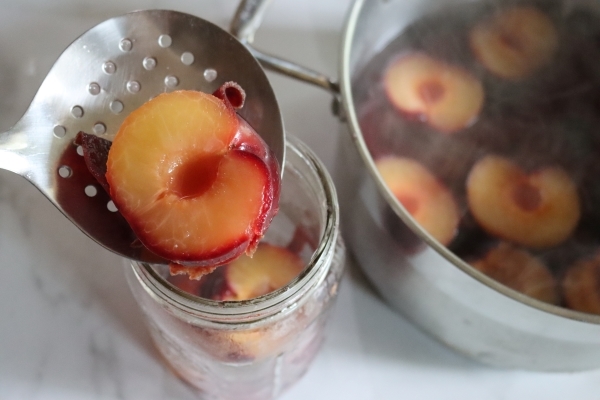
Raw Pack ~ Simply packing the prepared raw plums, either whole with pinpricks on the skin, or halves with pits removed, is much easier. The downside is the fruit will shrink considerably during canning, and you’ll have half-empty jars on the pantry shelf.
They’ll also float, and lose their shape more than hot packed fruit. (I know, it seems counter-intuitive, but pre-cooked hot pack plums actually hold their shape better in canning.)
For simplicity, I often find myself raw packing fruits, and that’s how I do it when canning pineapple or canning oranges. Stone fruits, however, are actually much better done hot pack, and I always do my peach canning with a hot pack.
I’m canning these plums hot pack, but feel free to use whatever method you prefer, as both plum canning methods are approved by the National Center for Food Preservation.
Syrup for Canning Plums
As with most fruits, the liquid for canning plums can be a wide variety of syrups or juices, depending on your preference.
It’s perfectly fine to can plums in just plain water, and that’s a great option for people hoping to can without added sugar. The problem with canning in plain water is the fruits will leach some of their natural sugars into the canning liquid, and water canned plums will taste washed out and less sweet than fresh fruit.
I generally can in extra light syrup, which roughly approximates the natural sweetness of fruits. That way, the fruit won’t lose sweetness from the canning liquid, but you’re not packing on the sugar either. For a 9-pint canner load, use 3/4 cups sugar and 6 1/2 cups water. For a 7-quart canner load, add 1 1/4 cups sugar to 10 1/2 cups water.
More sugar is fine if that’s your preference, and the NCFP has all the measurements you need for light through heavy syrup.
Canning in fruit juice, such as apple or grape, is also an option, as are alternative sweeteners like maple and honey.
Whatever you choose, ladle it hot over the fruit into the jars, leaving 1/2 inch headspace.
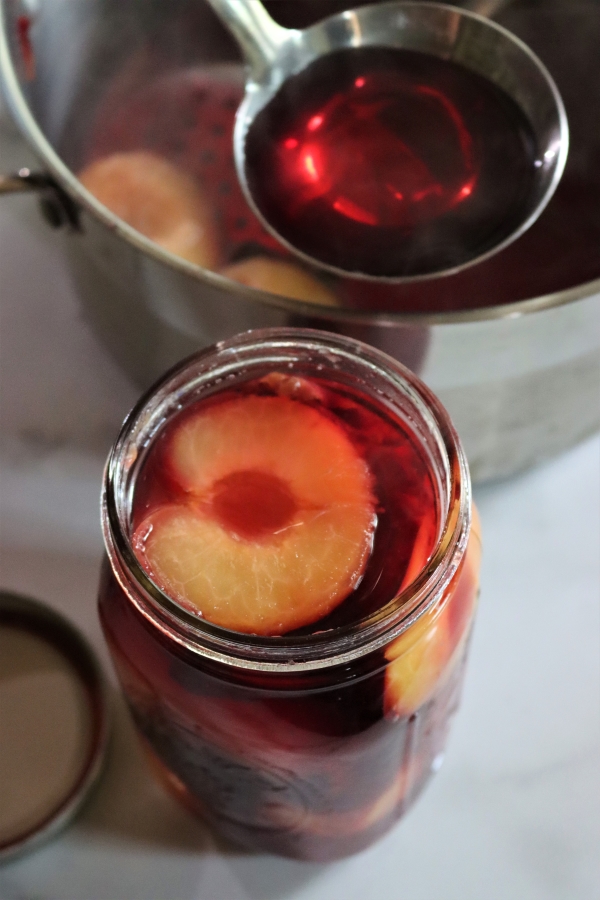
How to Can Plums
Once the fruit is packed into jars, be it hot pack or raw pack, it should be covered in a hot canning liquid of your choice. Be sure to leave 1/2 inch headspace, this will help ensure that the plums don’t push up into the canning lid and prevent sealing.
Cap the jars with 2 part canning lids and process them in a water bath canner for 20 minutes (pints) or 25 minutes (quarts) if you’re below 1000 feet in elevation. The total canning time will need to be adjusted for higher elevations.
- For 1,000 to 3,000 feet ~ Process 25 minutes for pints and 30 minutes for quarts.
- For 3,000 to 6,000 feet ~ Process 30 minutes for pints and 35 minutes for quarts.
- Over 6,000 feet ~ Process 35 minutes for pints and 40 minutes for quarts.
Once the canning time is complete, remove the jars to cool on a towel on the counter. Wait 24 hours before checking seals, and store any unsealed jars in the refrigerator for immediate use. Store sealed jars in the pantry, and they should retain quality for 12 to 18 months.
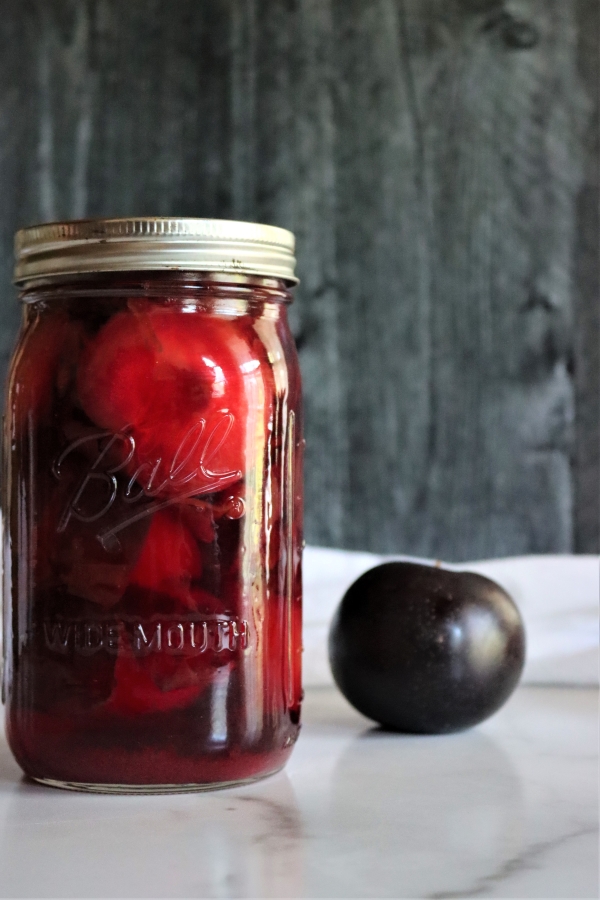
Ways to Preserve Plums
Looking for more plum preservation recipes?
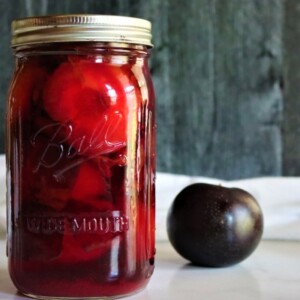
Canning Plums
Ingredients
- Plums, Roughly 2 lbs per quart jar, or 1 lb per pint
- Canning Liquid, Water, syrup or juice ~ See notes
Instructions
- Prepare a water bath canner.
- Prepare the plums for canning by either slicing them in half and removing their pits for plum halves, or pricking the outside with a toothpick for whole plums with pits.
- Prepare a canning liquid, either water, juice, or syrup (see notes) and bring it to a boil over high heat.
- Hot Pack ~ For hot pack plums (recommended), place the prepared fruit in the boiling liquid and cook for 2 minutes. Turn off the heat and place a lid on the pot. Allow the plums to sit in the hot liquid for 20 to 30 minutes to gently heat through. Then pack the hot fruit into canning jars.
- Raw Pack ~ If you choose raw pack instead of hot pack, simply pack the prepared fruit into canning jars.
- For both hot and raw pack, ladle the hot canning liquid over the top of the plums. This should cover them completely but leave 1/2 inch headspace.
- Remove bubbles, adjust headspace, and cap with 2 part canning lids to finger tight.
- Process in a water bath canner for 20 minutes (pints) or 25 minutes (quarts) at altitudes under 1000 feet (see notes below for higher elevations).
- When canning time is complete, remove the jars to a towel on the counter to cool and wait 24 hours before checking seals. Store any unsealed jars in the refrigerator for immediate use, and sealed jars in the pantry.
- Properly processed and sealed jars should maintain quality on the pantry shelf for 12-18 months.
Notes
- For 1,000 to 3,000 feet ~ Process 25 minutes for pints and 30 minutes for quarts.
- For 3,000 to 6,000 feet ~ Process 30 minutes for pints and 35 minutes for quarts.
- Over 6,000 feet ~ Process 35 minutes for pints and 40 minutes for quarts.
Fruit Canning Recipes
Preserving more than plums this season? Keep your canner full with these whole fruit canning recipes:
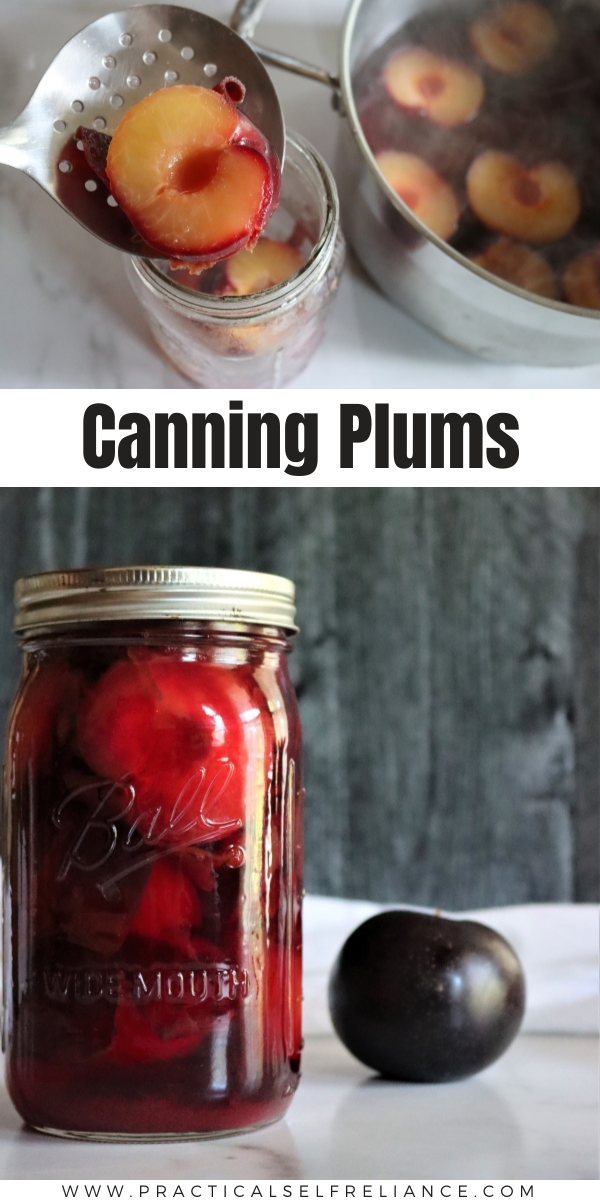
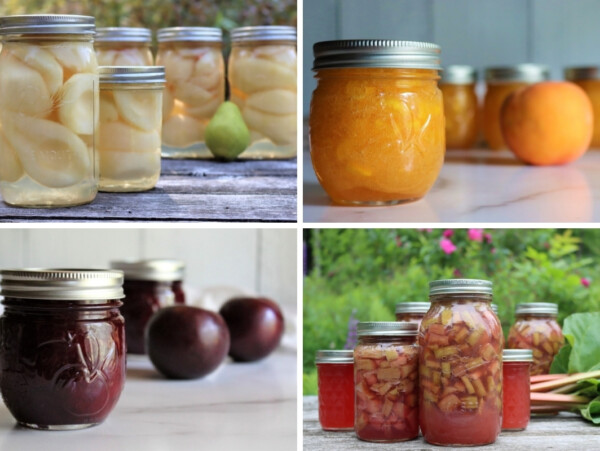
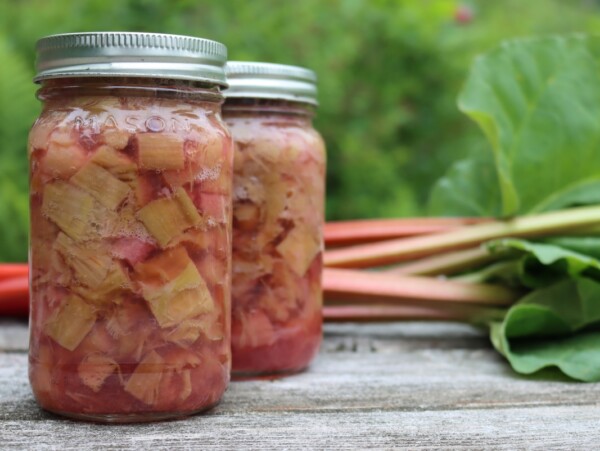
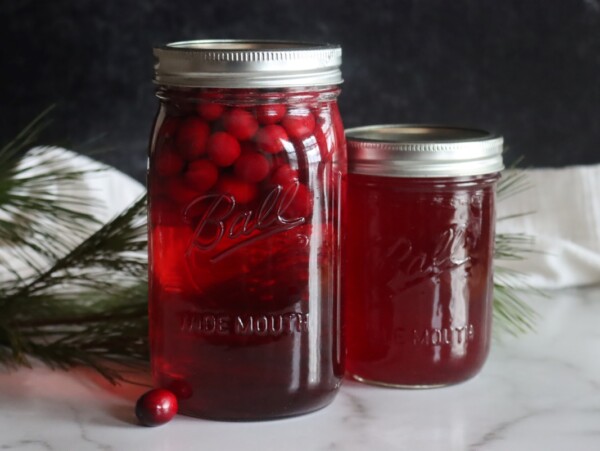
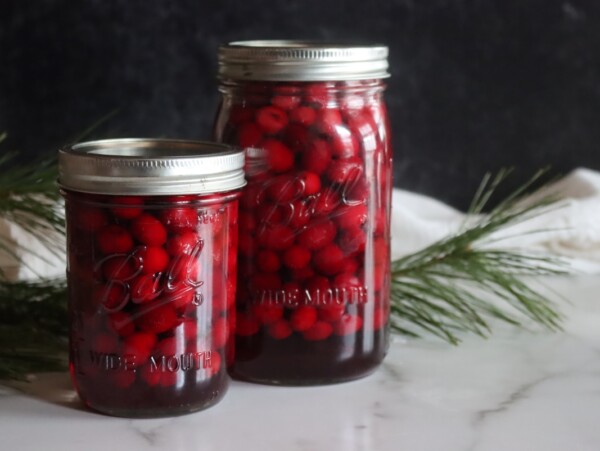










Yummy
Your notes are invaluable
Thank you!
Just a quick question. I have many jars of frozen plum juice. Well over 2 years worth. I still have to harvest 2 more plum trees. Can I use plum juice in the canning process while canning whole plums?
Thank you for your time
Of course! That’s a really good idea and I bet it’ll be delicious. In general, you can pretty much always substitute fruit juice when canning fruits in place of water or syrup. Enjoy!
I used meaty, perfect plums. The hot pack method made them mushy.
Did you can them whole?
I did one batch cold and the other hot packed, the cold pack turned out better the hot packed were way to mushy…
I am newer to canning (only tomatoes and apples one time each) and have had mixed outcomes. I tried hot packing the plums and they turned out mushy, possibly because it takes me about 30 mins to fill all of the jars, so the plums continue to sit in the hot liquid for a while. I am thrilled there was no siphoning (this happened with my apples) and I was able to make these with light syrup using honey. I am looking forward to trying this again when I receive another bag of gifted plums.
I’m sorry that happened. It can definitely take lots of practice to get it right. Don’t get discouraged. Just keep trying.
We just bought house that has an orchard with Asian Plums. Unfortunately, I’ve tried this hot pack method, altering it, and others, and they disintegrate at two minutes with the skins completely dissolving. Complete mush within 5 minutes. I think I’ll have to tough it out and spend days making salsa because these plums don’t seem to be able to be canned whole due to their very thin skins.
Any thoughts?
Thanks!
I would try the raw pack method and see if they hold up better that way.
Thank you for a great article! I am wondering if it’s OK to can other fruits whole (leaving the pits in). Apricot seeds contain a small amount of cyanide, and I don’t know if it would leak or leach out if canned with the fruit. Thanks for any help!
The toxins in these types of seeds are typically destroyed when cooked. With that said, The National Center for Home Food Preservation has an approved recipe for canning plums whole or halved but it looks like the apricots only have an option for halved or sliced. I’m not sure of the reason for that but you might want to do a little more research to see if there is an approved recipe.
What varieties of plums do you recommend that can well?
An article from Oregon State University recommends Early Italian, Parsons, yellow egg, Italian, green gage, or Brooks for canning.
Thank you so much for this article as I’ve received plums from a friend and dont know much what to do with them. I’m gonna try canning and dehydrating and maybe you can post your plum butter recipe because that sounds awesome! Thank you!
You’re welcome. So glad you enjoyed the post. Let us know how your canning and dehydrating goes.
I did the hot pack method and let them sit for 20 mins. They are very mushy. They are Italian plums, and are just ripe. I am wondering if after the 2 min boil, do I take the pan off the heat and let it sit 20 mins? I turned the burner off, but left the pan on the hot burner for 20 minutes.
I would try to remove them from the burner to see if that helps.
I followed this recipe for hot packing. My plums came out of the water very cooked and mushy. I still canned and processed them but I think I’ll only be able to use it for sauce or compote, maybe a cobbler. I had wanted to use them for pies but they are too cooked. I think leaving them in the liquid for 30 mins was too long.
I am sorry that happened. Were they overripe by chance? The standard process for hot pack is to let them sit for 20 to 30 minutes in the liquid so maybe you could try 20 minutes next time.
I think I let the liquid get too hot and then sitting for so long compounded the issue. I’ll have to try again.
Is it necessary to keep the plums in hot syrup for 30 minutes before canning or is just boiling for 2 enough? The canning process itself takes at least 20 minutes so I assume they will be tenderized during that.
I’m worried that that they will become too mushy.
You need to let them sit for 20 to 30 minutes if you want to do the hot pack method. If not, you can just do the raw pack method instead.
Plums are easy to can but after trying a fruit salad the manager of a restaurant I worked in I decided to try freezing some
They were terrific and I highly recommend it especially for baking thing!! I make this upside down cake with plums that is terrific.
That sounds lovely. Thanks for sharing.
I left all the plum pits in the canned plums then made a cake mix (lemon) then thought about consequence of cooking pit, being careful to sort while eating… is it only sort of ok to can or bake plum pits for consumption?
It’s totally ok to keep the pits in the plums if you are canning them whole but I would definitely recommend removing the pits before baking with them.
You mentioned you can use honey or maple as part of a syrup to can. Would you have any idea of the ratios please as I’m keen to try using one of those in a syrup to can my plums!
Generally, you use 3/4 cup of either honey or maple in place of each cup of sugar because they taste sweeter. Enjoy!
I am sooooo glad I found you! This was my 3rd attempt at plums and if I hadn’t had any success this time I think I would have just fed the lot to the chickens!
I ended up making plum butter with my 2nd attempt and the 1st was just rubbish! I always seem to make too much syrup too!
All that aside i followed your directions for hot pack and everything worked out well. Well except for the one lid blowing out. Oddly enough nothing siphoned out of that one!
anyeays, you win my vote for this one!
Thank you so much for your encouragement and kind words. We are so glad you enjoyed the article. It sounds like you had great success with your plums.
Any tips to prevent my plums from turning into slimy mush? Does that happen from over processing in the jar? I’m pretty sure I raw packed last time.
Using a meatier variety of plum can prevent them from turning to mush, as well as, making sure they’re at their peak ripeness.
I followed your directions for canning plums as stated above but I have a few questions and the reason I am asking is: the skins on my plums nearly came all off so, how many times do I need to poke the skin with a toothpick and, I wasn’t sure when to count the time after they start to boil…when I first see a few bubbles or a rapid boiling? I’m guessing I poked them too many times plus, I waited until I saw many bubbles. Thanks! I’m happy with my results even tho they aren’t perfect!
How well the skins are attached really depends on the plum variety, as some come off a lot easier than others. Just a few pokes is fine, just enough to let pressure escape so they don’t pop.